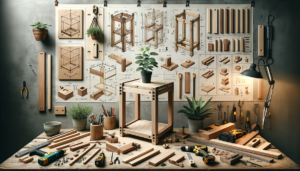
Build a wooden plant stand
Constructing a wooden plant stand is a great way to showcase your plants and enhance your gardening or indoor decor. This guide provides step-by-step instructions to build a sturdy and attractive wooden plant stand, suitable for intermediate woodworkers.
Materials and Tools Required
- Wood: Choose a weather-resistant wood like cedar, teak, or treated pine.
- Screws and Fasteners: Rust-proof screws for outdoor use.
- Sandpaper: Various grits for smooth finishing.
- Wood Glue: Weather-resistant if the stand will be outdoors.
- Finish: Wood sealant or paint suitable for the chosen wood type.
- Tools: Saw, drill, screwdriver, tape measure, level, clamps.
Step-by-Step Construction Guide
Step 1: Design and Planning
- Choose the Design: Determine the size and number of shelves.
- Sketch the Stand: Draw a detailed plan with dimensions.
Step 2: Cutting the Wood
- Measure and Mark: Accurately measure and mark your wood pieces.
- Cutting: Use a saw to cut legs, shelves, and support braces.
Step 3: Assembling the Stand
- Assembling Shelves: Attach shelves to the legs using screws and wood glue.
- Adding Supports: Secure support braces for added stability.
Step 4: Sanding and Finishing
- Sanding: Smooth all surfaces, starting with a coarse grit and moving to finer grits.
- Finishing: Apply a sealant or paint to protect the wood and enhance its appearance.
Step 5: Final Assembly
- Attach All Components: Ensure all parts are securely fastened.
- Leveling: Check that the stand is level and stable.
Tips for a Successful Project
- Wood Selection: Choose wood that withstands environmental elements.
- Precise Measurements: Accuracy is key to a well-fitted stand.
- Quality Finish: Apply a durable finish to protect against weather.
FAQs
- What type of wood is best for a plant stand? Weather-resistant woods like cedar, teak, or treated pine are ideal.
- How can I ensure the stand is stable? Use sturdy joints, and add diagonal braces for extra stability.
- Can I adjust the size of the plant stand? Absolutely. Modify the dimensions in the design phase to suit your space and needs.
Conclusion
Building a wooden plant stand is an enjoyable and practical project. It not only provides a beautiful display for your plants but also adds a personal touch to your gardening or home decor. With the right materials, tools, and a bit of patience, you can create a durable and attractive plant stand.
Additional Resources
- Choosing Durable Wood for Outdoor Projects
- Basic Woodworking Techniques
- Applying Wood Finishes Effectively
Embarking on this woodworking project is a fantastic way to combine your love for plants with the satisfaction of building something with your own hands. Take your time, enjoy the process, and soon you’ll have a beautiful stand to display your greenery. Happy woodworking!